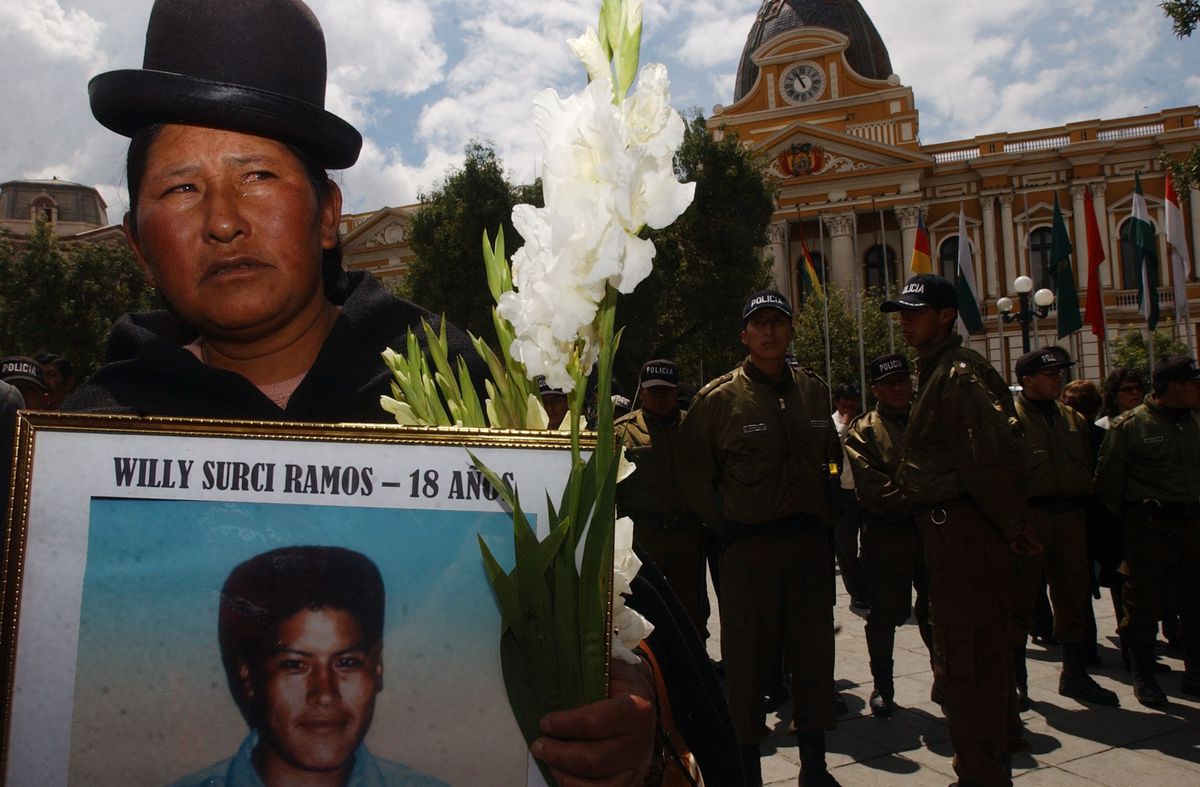 A woman holds a picture of her son, who was murdered during the 2003 protests in El Alto, in an archive. DADO GALDIERI (AP)
A woman holds a picture of her son, who was murdered during the 2003 protests in El Alto, in an archive. DADO GALDIERI (AP)
Exactly 20 years after the 2003 “Black October” massacre, in which 58 anti-government protesters died in the Bolivian city of El Alto and surrounding areas, the two main defendants in the events, former President Gonzalo Sánchez de Lozada and former Minister of Defense Carlos, were named Sánchez Berzaín will pay compensation to the families of eight victims. This concludes the civil case that these families have been pursuing for 16 years in Florida, USA. The agreement prohibits the parties from disclosing the amount of compensation and does not imply that the defendants accept “responsibility for the events in question.”
“This is a historic day,” summed up Thomas Becker, the leader of the prosecution brought in the US justice system on behalf of the families of eight people murdered during the 2003 protests against Sánchez de Lozada. “We are at the end.” an agreement. “We cannot talk about the details, but we can talk about the statement that both sides have prepared, which says that we have decided to end the process,” Becker told the Bolivian press. The lawsuit represented by this attorney was supported by the International Human Rights Clinic at Harvard Law School and the Center for Constitutional Rights, a nonprofit organization. “The door for appeals is closed. Neither they can appeal, nor can we. This leaves the 2018 ruling indicating that Sánchez de Lozada and Sánchez Berzaín are responsible for extrajudicial killings. “That’s why it’s a victory for the Bolivian people,” explained Becker. Lawyers for 93-year-old Sánchez de Lozada declined to provide their perspective when asked by American media due to the confidentiality of the agreement.
In 2018, the victims’ families obtained a guilty verdict in the first instance, forcing the defendants to pay $10 million. This decision was not implemented because they appealed to a judge who rejected the victims’ initial victory, so they had to appeal themselves. These resources from both parties have now been cut.
The trial was conducted under the US Torture Victims Protection Act. In the hearings of the first phase of the trial, a former soldier involved in the massacre stated that the military had received orders to shoot at “everything that moved” to help a tanker convoy carrying gasoline on October 12, 2003 to enable the crossing. the blockade of roads by the residents of El Alto. This protest prevented the neighboring city of La Paz, the country’s administrative capital, from being supplied with gasoline. To reach La Paz, the so-called “death convoy” had to cross the blocked streets of El Alto. It is estimated that 25 people died as the military attack vehicles guarding the gasoline passed by. An additional 33 Bolivians died before and after this date due to repression by the forces led by Sánchez Berzaín.
The forced opening of El Alto was supported by a government decree authorizing the military to intervene and use firearms if necessary. The cabinet signed it, but not then-Vice President Carlos Mesa, who considered it a mistake not to negotiate with the protesters. They initially called for the cancellation of a project to export Bolivian gas to the United States via Chile and other demands for nationalist reasons, but then referred to the resignation of Sánchez de Lozada, who is considered the Bolivian “patriarch of neoliberalism”. He initially assured that he would not resign, but only resisted until October 17. That day, cornered by popular protests that had paralyzed part of the country, he fled to the United States. Sánchez Berzaín accompanied him. Both sought asylum in that country and as a result could not be caught by the Bolivian justice system, which sentenced the former commanders of the armed forces to prison terms of 15 years or more and the former ministers of Sánchez de Lozada who remained in the country. country, sentenced to around three years in prison. The trial in the United States was the first in which a former fugitive head of state from that country appeared before the civil justice system to answer for such serious crimes. “Even farmers can win against the most powerful and no one is above the law,” cheered Becker.
Sánchez de Lozada, a wealthy miner considered one of Bolivia’s richest men, has held the presidency twice. The first between 1993 and 1997, when he implemented deep neoliberal reforms and privatized oil and energy, mines, railways and state-owned telecommunications. He began his second term in 2022, amid an economic crisis and strong social unrest against the privileges of oil companies. At that time, they owned the oil and gas they produced. After his departure from the country, he was replaced by Mesa and a new political cycle began in which Evo Morales was to be the central figure. On May 1, 2006, Bolivia nationalized the oil industry.
Join EL PAÍS to follow all the news and read without restrictions.
Subscribe to
Follow all international information on Facebook and Xor in our weekly newsletter.

